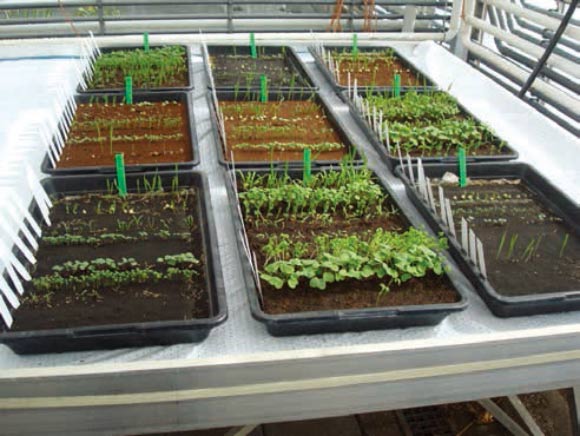A new experiment conducted by researchers at the Wageningen University & Research in the Netherlands shows that it’s possible to grow crops on Martian and lunar soil simulants.

Wamelink et al were able to harvest radishes and radish seeds, cress and cress seeds, rye seeds, rocket, tomatoes and peas on Mars and Moon soil simulants. This photo shows experimental trays on April 16, 2015, seven days after sowing. Image credit: Wamelink et al, doi: 10.1515/opag-2019-0051.
“A human settlement on Mars or the Moon is becoming more realistic. Several countries and private companies are preparing for this journey,” said lead author Dr. Wieger Wamelink and colleagues.
“One of the major issues will be ensuring food availability and safety.”
“Food can and will be brought along, but for a permanent stay, production of crops on Mars or the Moon to supplement or even supply the total food demand could be a necessity.”
For their experiments, the researchers selected ten crop species: garden cress, rocket, tomato, radish, rye, quinoa, spinach, chives, peas, and leek.
They simulated the properties of Martian and lunar regolith and used ‘normal’ soil (potting soil from Earth) as a control.
“Mars regolith is not yet available on Earth. Instead we used NASA’s Mars regolith simulant JSC 1A,” they explained.
“Moon regolith has been brought to Earth. However, it is not available for growing plants at sufficient quantities at the moment. Therefore, instead of actual Moon regolith we used the JSC 1A Moon simulant provided by NASA.”
The simulants were mixed with organic matter to mimic the addition of residues from earlier harvests.
Ten crops were sown in random lines in trays. Nine of the ten species grew well with the exception of spinach.
The biomass production on the Martian soil simulant was comparable to the Earth soil. The biomass production on the lunar soil simulant was significantly lower than for the Earth soil.
The seeds produced by three species (radish, rye and garden cress) were tested successfully for germination.
“We were thrilled when we saw the first tomatoes ever grown on the Mars soil simulant turning red,” Dr. Wamelink said.
“This means that the next step towards a sustainable closed agricultural ecosystem had been taken.”
The scientists described their experiment in a paper in the journal Open Agriculture.
_____
G.W.W. Wamelink et al. 2019. Crop growth and viability of seeds on Mars and Moon soil simulants. Open Agriculture 4 (1); doi: 10.1515/opag-2019-0051







